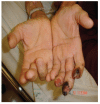Churg-Strauss syndrome and hemorrhagic vasculitis
- PMID: 25386301
- PMCID: PMC4211497
- DOI: 10.4081/dr.2011.e49
Churg-Strauss syndrome and hemorrhagic vasculitis
Abstract
Churg-Strauss syndrome (CSS) is a rare syndrome characterized by sinusitis, asthma and peripheral eosinophilia. This vasculitic syndrome affects medium and small-sized vessels, the lung being the most commonly affected organ, followed by the skin. The authors report a case of a 59-year-old male with a past history of asthma and allergic rhinitis. He presented necrohemorragic lesions in the distal phalanx of the 2(nd), 3(rd) and 4(th) fingers of the left-hand and petechial lesions in the plant of both feet, accompanied by asthenia, anorexia and weight loss. The analytical study revealed leukocytosis with eosinophilia, elevated inflammatory parameters and p-ANCA positive antibodies. The diagnosis of CSS was established based on clinical and histopathological data. Cutaneous manifestations of hemorragic vasculitis are rare in CSS syndrome but can be the first manifestation of the disease. The recognition of this presentation is important for the early diagnosis and treatment of this syndrome.
Keywords: Churg-Strauss syndrome; asthma; eosinophilia; p-ANCA; polyneuropathy.; vasculitis.
Conflict of interest statement
Conflict of interest: the authors have no conflict of interest.
Figures
Similar articles
-
[Churg-Strauss syndrome presenting with cutaneous vasculitis].Acta Reumatol Port. 2009 Apr-Jun;34(2A):281-7. Acta Reumatol Port. 2009. PMID: 19569284 Portuguese.
-
Torasemide-induced Vascular Purpura in the Course of Eosinophilic Granulomatosis with Polyangiitis.Acta Dermatovenerol Croat. 2022 Sep;30(2):116-118. Acta Dermatovenerol Croat. 2022. PMID: 36254546
-
A case of churg-strauss syndrome.Ann Dermatol. 2009 May;21(2):213-6. doi: 10.5021/ad.2009.21.2.213. Epub 2009 May 31. Ann Dermatol. 2009. PMID: 20523791 Free PMC article.
-
Systemic vasculitis with asthma and eosinophilia: a clinical approach to the Churg-Strauss syndrome.Medicine (Baltimore). 1984 Mar;63(2):65-81. doi: 10.1097/00005792-198403000-00001. Medicine (Baltimore). 1984. PMID: 6366453 Review.
-
Churg-Strauss syndrome.Autoimmun Rev. 2015 Apr;14(4):341-8. doi: 10.1016/j.autrev.2014.12.004. Epub 2014 Dec 11. Autoimmun Rev. 2015. PMID: 25500434 Review.
Cited by
-
ANCA-Positive Small-Vessel Vasculitis Following SARS-CoV-2 Vaccination-A Systematic Review.Vaccines (Basel). 2024 Jun 13;12(6):656. doi: 10.3390/vaccines12060656. Vaccines (Basel). 2024. PMID: 38932385 Free PMC article. Review.
References
-
- Hellmich S, Ehlers E, Csernok WL. Gross. Update on the pathogenesis of Churg-Strauss syndrome. Clin Exp Rheumatol. 2003;21:69–77. - PubMed
-
- Hauser T, Mahr A, Metzler C, et al. The leukotriene receptor antagonist montelukast and the risk of Churg-Strauss syndrome: a case-crossover study. Thorax. 2008;63:677–82. - PubMed
-
- Guillevin L, Lhote F, Gayraud M, et al. Prognostic factors in polyarteritis nodosa and Churg-Strauss syndrome. A prospective study in 342 patients. Medicine (Baltimore) 1996;75:17–28. - PubMed
-
- Della Rossa A, Baldini C, Tavoni A, et al. Churg-Strauss syndrome: clinical and serological features of 19 patients from a single lian centre. RheumatologItay (Oxford) 2002;41:12842–12842. - PubMed
LinkOut - more resources
Full Text Sources
Miscellaneous



